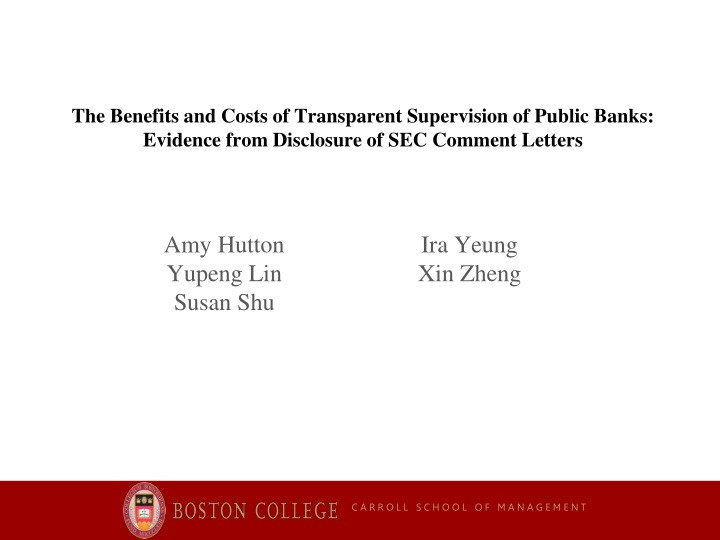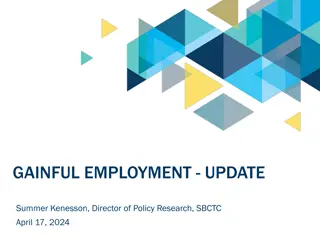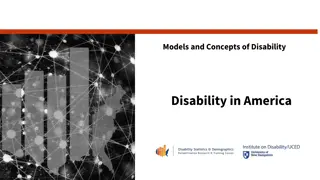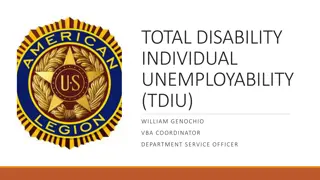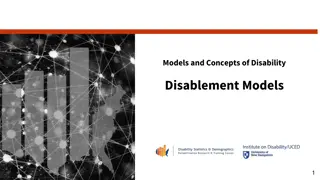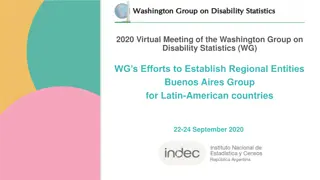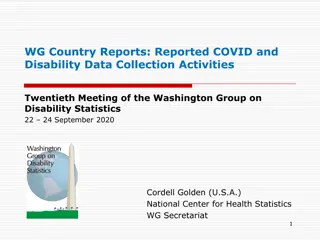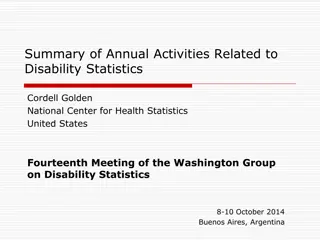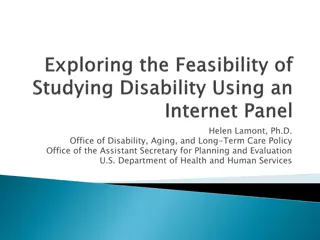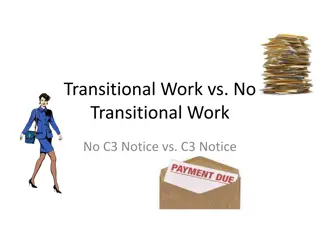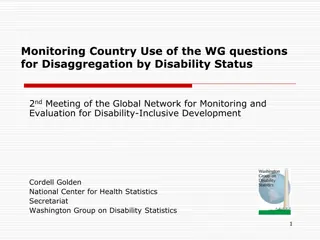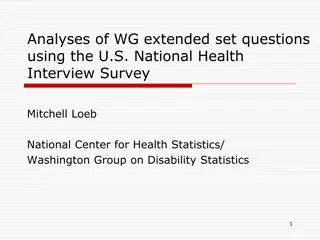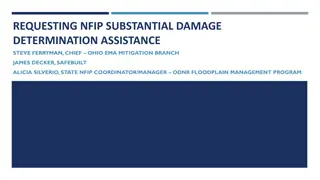Basics of Disability Programs and Substantial Gainful Activity
Disability programs such as SSDI and SSI provide support to individuals who meet specific disability criteria. Substantial Gainful Activity (SGA) is a measure used to determine one's ability to engage in work activity. Work incentives and employment supports aim to assist beneficiaries in transitioning to independence by protecting their eligibility for benefits while encouraging workforce participation.
Download Presentation

Please find below an Image/Link to download the presentation.
The content on the website is provided AS IS for your information and personal use only. It may not be sold, licensed, or shared on other websites without obtaining consent from the author.If you encounter any issues during the download, it is possible that the publisher has removed the file from their server.
You are allowed to download the files provided on this website for personal or commercial use, subject to the condition that they are used lawfully. All files are the property of their respective owners.
The content on the website is provided AS IS for your information and personal use only. It may not be sold, licensed, or shared on other websites without obtaining consent from the author.
E N D
Presentation Transcript
The Benefits and Costs of Transparent Supervision of Public Banks: Evidence from Disclosure of SEC Comment Letters Amy Hutton Yupeng Lin Susan Shu Ira Yeung Xin Zheng C A R R O L L S C H O O L O F M A N A G E M E N T
Research Question What are the effects of Enhanced Regulatory Transparency on the U.S. Banking System? Does Public Disclosure of SEC Comment Letters lead to changes in public banks behavior? Lending Decision Financial Reporting Quality C A R R O L L S C H O O L O F M A N A G E M E N T
Research Design Difference n Difference SEC policy change 1998 2004 2011 PRE public disclosure of SEC CLs POST public disclosure of SEC CLs Private Reviews Public Reviews Only Public Banks receive SEC CLs: We compare 219,377 Private bank quarters to 37,071 Public bank quarters C A R R O L L S C H O O L O F M A N A G E M E N T
Enhance Regulatory Transparency SEC s 2004 policy shift to publicly disclose its Comment Letter correspondence. Prior to 2004, SEC Comment Letters were only accessible via FOIA requests. The SEC s stated objective for this policy change - to alleviate both the delay in and the selective nature of the access to SEC comment letters. Most frequent CL topics the quality of banks loan loss provisions and reserves. C A R R O L L S C H O O L O F M A N A G E M E N T
Theory: Regulatory Transparency & the Banking System Bright-side of transparency Enhances monitoring of banks lending decisions and capital requirements more efficient pricing of capital, reduces undue risk-taking & reduces agency problems between bank regulators and the public. Dark-side of transparency Discourages risk sharing among banks capital providers (e.g., depositors and other banks) increasing banks funding costs, reducing access to credit and potentially resulting in economic instability (bank runs) C A R R O L L S C H O O L O F M A N A G E M E N T
Enhanced Regulatory Transparency Banks finl reporting Alerts Capital Providers to potential problems greater scrutiny, potentially higher funding costs and less access to needed liquidity Regulatory Spill-over Effects: the greater public awareness of banks reporting deficiencies is likely to pressure other bank regulators to take enforcement actions. To ward off unwanted scrutiny, public banks will adopt more conservative financial reporting, specifically more timely loan loss provisions. C A R R O L L S C H O O L O F M A N A G E M E N T
Timeliness of Loan Loss Provisions 8 7 6 5 4 3 Post 2 1 Pre 0 Private Banks Public Banks C A R R O L L S C H O O L O F M A N A G E M E N T
Enhanced Regulatory Transparency - lending Hirshleifer effect discourages risk-sharing among banks and depositors, negatively affecting the liability side of banks balance sheets banks funding costs will increase, which in turn reduces banks capacity to make new loans and aggravates lending procyclicality. On the other hand, enhanced market & regulatory discipline ought to encourage banks to adjust their loan portfolios towards less risky borrowers C A R R O L L S C H O O L O F M A N A G E M E N T
Loan Growth The Decline in Loan Growth - Pre to Post 3.5 3 3.5 3 2.5 2.5 2 2 1.5 1.5 1 1 Pre 0.5 0.5 Post 0 0 Private Banks Public Banks Private Banks Public Banks C A R R O L L S C H O O L O F M A N A G E M E N T
Private Banks Public Banks Loan Growth Loan Growth GDP Growth GDP Growth ProCyclicality Pre ProCyclicality Post ProCyclicality Pre ProCyclicality Post C A R R O L L S C H O O L O F M A N A G E M E N T
Borrower Risk 6.00 5.00 4.00 3.00 2.00 Pre 1.00 Post 0.00 Private Banks Public Banks C A R R O L L S C H O O L O F M A N A G E M E N T
Does the public disclosure of SEC CLs change the consequences for public banks receiving the CLs? SEC policy change 1998 2004 2011 Banks Receiving SEC CL No Public Disclosure Banks Receiving SEC CL Publicly Disclosed C A R R O L L S C H O O L O F M A N A G E M E N T
Decline in Rates from Pre to Post Deposit Rates 350 350 300 300 250 250 200 200 150 150 100 Pre 100 50 50 0 Post No CL (105 basis pts) CL (39 basis pts) 0 No CL CL C A R R O L L S C H O O L O F M A N A G E M E N T
EDOs Issued to Opaque Banks 0.06 0.05 0.04 0.03 0.02 Post 0.01 Pre 0 No CL CL C A R R O L L S C H O O L O F M A N A G E M E N T
EDOs issued to Politically Connected Banks 0.1 0.09 0.08 0.07 0.06 0.05 0.04 0.03 Post 0.02 0.01 Pre 0 No CL CL C A R R O L L S C H O O L O F M A N A G E M E N T
Robustness tests: Timeliness, Loan Growth, Procyclical Lending Exclude 10 largest public banks Exclude banks with more than $200MM in assets Delete the period before SOX (August 2002) Include the Financial Crisis Period (Q42007 Q22009) Delete the period after the start of the Financial Crisis (Q42007 and beyond) LLP not robust C A R R O L L S C H O O L O F M A N A G E M E N T
Conclusion We demonstrate empirically the trade-offs between two theoretical effects of increased regulatory transparency: greater market discipline and reduced risk-sharing (Goldstein and Sapra 2014; Acharya and Ryan 2016). The empirical demonstration of these theoretical effects should be of interest to bank regulators and policymakers C A R R O L L S C H O O L O F M A N A G E M E N T
Thank You C A R R O L L S C H O O L O F M A N A G E M E N T
